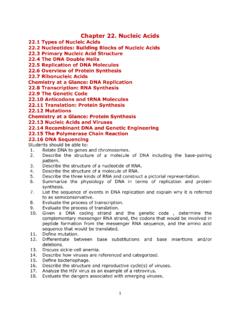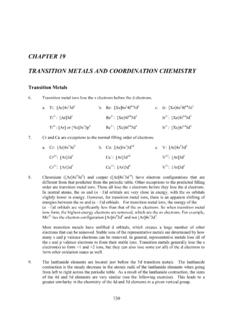Transcription of Chapter 18: Carbohydrates - latech.edu
1 Chapter 18: Carbohydrates Instructional Objectives 1. Know the difference between complex and simple Carbohydrates and the amounts of each recommended in the daily diet. 2. Know the difference between complex and simple Carbohydrates and the amounts of each recommended in the daily diet. 3. Understand the concepts of chirality, enantiomers, stereoisomers, and the D and L-families. 4. Recognize whether a sugar is a reducing or a nonreducing sugar. 5. Discuss the use of the Benedict's reagent to measure the level of glucose in urine. Draw and name the common, simple Carbohydrates using structural formulas and Fischer projection formulas. 6. Given the linear structure of a monosaccharide, draw the Haworth projection of its a- and 0-cyclic forms and vice versa. Discuss the structural, chemical, and biochemical properties of the monosaccharides, oligosaccharides, and polysaccharides. 7.
2 Know the difference between galactosemia and lactose intolerance. Biochemistry--An Overview Biochemistry is the study of the chemical substances found in living organisms and the chemical interactions of these substances with each other. It deals with the structure and function of cellular components, such as proteins, Carbohydrates , lipids, nucleic acids, and other biomolecules. There are two types of biochemical substances: bioinorganic substances and Inorganic substances: water and inorganic salts. Bioorganic substances: Carbohydrates , Lipids, Proteins, and Nucleic Acids. Complex bioorganic/inorganic Molecules: Enzymes, Vitamins, DNA, RNA, and Hemoglobin etc. As isolated compounds, bioinorganic/bioorganic/complex substances have no life in and of themselves. Yet when these substances are gathered together in a cell, their chemical interactions are able to sustain life.
3 Plant Materials It is estimated that more than half of all organic carbon atoms are found in the carbohydrate materials of plants. Human uses for Carbohydrates of the plant kingdom extend beyond food. Carbohydrates in the form of cotton and linen are used as clothing. Carbohydrates in the form of wood are used for shelter and heating and in making paper. Occurrence and Functions of Carbohydrates Almost 75% of dry plant material is produced by photosynthesis. Most of the matter in plants, except water, are carbohydrate material. Examples of Carbohydrates are cellulose which are structural component of the plants, starch the energy reservoir in plants and glycogen (animal starch) found in animal tissues and human body in smaller quantities. Plant products are the major source of Carbohydrates and average human diet contains 2/3 of Carbohydrates . Recommended percents in the daily diet: Recommended Carbohydrates ~ 60 % Recommended sucrose less than 10% Usefulness of Carbohydrates is their ability to produce energy when they under go oxydation during respiration.
4 Storage carbohydrate, in the form of glycogen, provides a short-term energy reserve for bodily functions. Carbohydrates supply carbon atoms for the synthesis of other biochemical substances (proteins, lipids, and nucleic acids). Carbohydrates also form a part of the structural framework of DNA and RNA molecules. Carbohydrates linked to lipids as discussed in Chapter 19 are structural components of cell membranes. Carbohydrates linked to proteins as discussed in Chapter 20 function in a variety of cell cell and cell molecule recognition processes as useful markers forantibodies. Classification of Carbohydrates Organic compounds containing many -OH groups (polyhydroxy), and aldehydes or ketones functional groups. By convention, the ending "-ose" is reserved for sugars ( sucrose and glucose) in the class of Carbohydrates .
5 Carbohydrates are produced by the process of photosynthesis in which six carbon sugars or hexoses are produced using energy of sunlight, green pigment chlorophyll, CO2 and H2O by green plants. The hexoses produced are the raw material for the biosynthesis of glycogen, fats, proteins and nucleic acid in living systems. Simpler Formula for Cabohydrates: CnH2nOn or Cn(H2O)n (hydrates of C) n= number of atoms Monosaccharides They consist of one sugar containing 3,4,5,6 and 7 carbon atoms and are usually colorless, water-soluble, crystalline solids. Some monosaccharides have a sweet taste. Examples of monosaccharides include glucose (dextrose), fructose (levulose), galactose, xylose and ribose. Disaccharides a sugar (a carbohydrate) composed of two monosaccharides. Oligosaccharide An oligosaccharide is a saccharide polymer containing a small number (typically 3-10 monosaccharides Polysacharides Are relatively complex Carbohydrates .)
6 They are polymers made up of many monosaccharides joined together by glycosidic bonds. They are insoluble in water, and have no sweet taste. Monosaccharide structures and types Aldoses :Aldehyde sugars are called aldoses. Ketoses: Ketone sugars are called ketoses. Drawing Sugar Molecules Linear structure-Fischer projection of a monosaccharide Aldose Ketose Haworth projection showing cyclic forms: - and - forms. The normal form of most sugars is in a cyclic hemiacetal form shown as a Haworth projection. In solution, less than 1% of a sugar will be in the linear form as shown in Fischer structure below on the right. In solution, over 99% of the sugar will be in a cyclic ring structure which is represented by Haworth structures on the left. The preferred form varies from sugar to sugar: some prefer to be a 6-member ring "pyranose", like glucose.
7 The cyclic ring structures of sugars are formed by the intramolecular hemiacetal formation as we described in Chapter 15. ALDEHYDE sugar or aldoses + alcohol --- hemiacetal (cyclic ring) KETONE sugar or ketoses + alcohol --- hemiketal (cyclic ring) They are polyhydroxy aldehydes (sucah as glucose)or ketones (such as fructose) or compounds that produce such substances upon hydrolysis. Sugars are classified according to their structures: according to number of carbon atoms in the sugar and number of sugar units/molecule in a polymer formed by the glycosidic bonds. Number fo carbon atoms Triose sugar units containing three carbon atoms Tetroses sugar units containing four carbon tomsa Pentoses sugar units containing five carbon atoms Hexoses sugar units containing six carbon atoms Steps for drawing Fischer structures of sugars: A monosaccharides can be "sorted" according to the length of the carbon chain in the sugar unit.
8 1. write the carbon chain vertically with the aldehyde or ketone group toward the top of the chain. 2. number the carbons. 3. place the aldehyde or ketone group. 4. place H and OH groups. 5. identify the chiral centers. 6. note the highest numbered chiral center to distinguish D and L sugars. 7. write the correct common name for the sugar. Aldose-Trioses Hexoses Mnemonics for remembering sugar names All(allose) altruist (altrose) gladly (glucose) make (mannose) gum (gulose) in (idose) gallon (galactose) tanks (tallose) Number fo units Saccharide- (derived from Latin for sugar) is the chemical name for a sugar unit: Monosaccharide (one sugar unit); Disaccharide (two sugar units); Oligosaccharide (2 to 10 sugar units); Polysaccharide (over 10 sugar units). Monosaccharides also can be named based on their functional groups. Aldoses: Monosaccarides with aldehyde functional group.
9 D-glucose Ketoses: Monosaccarides with keto functional group. D-fructose Simple Carbohydrates : Monosaccharide and Disaccharide of simple sugars such as glucose or fructose. Disaccharide are two monsaccharides connected by a bridging O atom called a glycosidic bond as in sucrose. Glycosidic bond- covalent bond between a hemiacetal or hemiketal and an alcohol. Glycoside- compound formed when a sugar in the cyclic form is bonded to an alcohol through a glycosidic bond to another sugar molecule as shown below. Chirality: Handedness in Molecules Most monosaccharides exist in two forms: a left handed and right handed form - same as two hands Two types of objects: - Superimposible on their mirror images: -- images that coincide at all points when the images are laid upon each other -- a dinner plate with no design features -- Achiral - Non-superimposible on their mirror images: Chiral (handedness) Properties of light Ordinary Light.
10 Move in all directions Plane polarized light move only in one direction (see Figure on right below) Plane polarized light is rotated clockwise (to right) or counterclockwise (to left) when passed through enantiomers Direction and extent of rotation will depend upon the enantiomer Same concentration of two enantiomers rotate light to same extent but in opposite direction The way to tell apart the handedness of a molecule is to expose them to plane polarized light CHOHOHCCH OH2CH OH2 HCHOHOCHOHCCH OH2 OHCH OH2 HCHOOH Light is passed through a polarized filter. A solution of an optical isomer will rotate the light one direction. Classification of the molecule based on the rotation of plane-polarized light. Dextrorotatory - rotate clockwise shown using (+) symbol or - usually D isomers Levorotatory - rotate anti-clockwise shown using (-) symbol or - usually L isomers Stereoisomerism: Enantiomers and Diastereomers Stereoisomers are isomers that have the same molecular and structural formulas but differ in the orientation of atoms in space.








